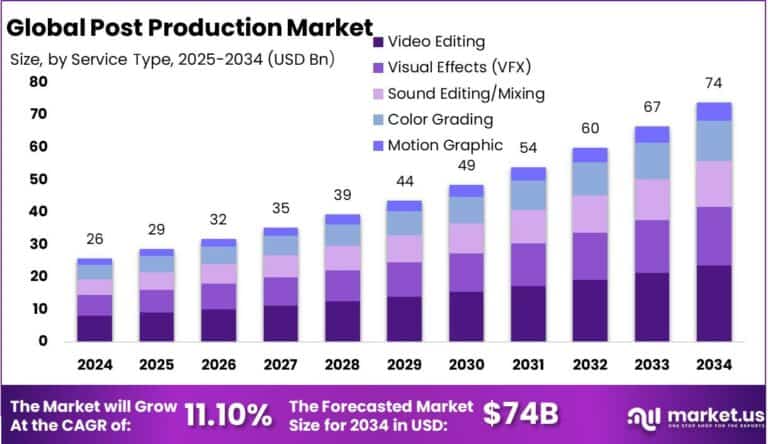Table of Contents
The Global Post Production Market is projected to grow from USD 25.85 billion in 2024 to approximately USD 74 billion by 2034, registering a steady CAGR of 11.10% during 2025-2034. This growth is fueled by increasing demand for high-quality content in film, television, advertising, and digital media. The surge in streaming platforms and technological advancements in visual effects (VFX), animation, and editing tools are accelerating post-production activities worldwide. In 2024, North America dominated with a 37% market share, generating USD 9.56 billion in revenue, supported by the U.S. market’s robust growth.

How Tariffs Are Impacting the Economy
Tariffs on imported hardware and software components crucial for post-production workflows, such as advanced graphics processors, editing consoles, and software licenses, have led to increased costs for studios and production houses. The U.S. tariffs targeting imports from key manufacturing countries have raised capital expenditures, affecting budgets for equipment upgrades and new technology adoption.
➤ Discover how our research uncovers business opportunities @ https://market.us/report/post-production-market/free-sample/
(Use corporate mail ID for quicker response)
These tariffs disrupt global supply chains, causing delays in procurement and installation of essential tools. The increased costs can slow down production timelines and reduce overall efficiency, potentially impacting content delivery schedules. While tariffs aim to protect domestic industries, they introduce inflationary pressures and create uncertainties that may hinder innovation and investment in the post-production sector.

Impact on Global Businesses
Global post-production companies face rising costs for hardware and software due to tariffs, resulting in tighter budgets and postponed technology upgrades. Delays in acquiring advanced graphics cards, editing systems, and VFX software impact content quality and delivery schedules. Sectors like film, television, and digital media production experience heightened pressure to balance cost and creativity. Companies are diversifying suppliers, increasing local sourcing, and adopting cloud-based post-production platforms to mitigate supply chain disruptions. Enterprises investing in automation and AI-powered editing tools are better positioned to maintain efficiency and competitive advantage despite tariff challenges.
Strategies for Businesses
To manage tariff-induced challenges, businesses are:
- Diversifying supply chains and sourcing locally where possible
- Increasing investments in cloud-based post-production platforms
- Leveraging automation and AI-driven editing tools to optimize workflows
- Engaging in policy advocacy for tariff relief and trade facilitation
- Prioritizing flexible procurement and inventory management strategies
These approaches help maintain growth and operational efficiency amid economic uncertainties.
Key Takeaways
- Post-production market to grow at 11.10% CAGR through 2034
- Tariffs increase hardware/software costs, impacting budgets and timelines
- Supply chain diversification and local sourcing enhance resilience
- Cloud-based and AI-powered platforms improve efficiency
- Policy advocacy is crucial for mitigating trade-related risks
➤ Get full access now @ https://market.us/report/post-production-market/free-sample/
Analyst Viewpoint
Despite tariff-related cost pressures, the post-production market’s strong growth fundamentals remain intact. Demand for premium content and advancements in AI and cloud technology drive innovation and efficiency. Companies embracing digital workflows and supply chain agility will lead the market. Stabilizing trade policies are expected to reduce uncertainties. The future outlook is positive as post-production evolves to meet growing global content consumption and technological complexity.
Regional Analysis
North America dominates the post-production market, led by the U.S., with high investment in film and digital media production and adoption of advanced technologies. Europe follows with strong creative industries and growing demand for streaming content. Asia-Pacific is the fastest-growing region due to expanding film markets, digital media consumption, and rising investments in post-production infrastructure in countries like India, China, and South Korea. Latin America and the Middle East show emerging potential driven by content localization and infrastructure development.
➤ Discover More Trending Research
- Tax Tech Market
- AI-Powered Asset Tracking System Market
- Predictive Agents Market
- Smart Asset Management in Utility Market
Business Opportunities
Opportunities in the post-production market arise from increasing demand for VFX, animation, color grading, and sound editing services. The rise of OTT platforms fuels the need for faster, high-quality post-production workflows. AI-powered automation tools open avenues for efficiency and creative innovation. Emerging markets offer growth potential due to rising local content production. Additionally, cloud-based post-production solutions enable remote collaboration, expanding access and reducing costs for small and mid-sized studios.
Key Segmentation
The post-production market is segmented by:
By Service Type
- Visual Effects (VFX)
- Animation
- Editing and Color Grading
- Sound Design and Mixing
- Others
By Deployment Mode
- On-Premise
- Cloud-Based
By End-User Industry
- Film and Television
- Advertising
- Digital Media and OTT Platforms
- Gaming
By Region
- North America
- Europe
- Asia-Pacific
- Latin America
- Middle East & Africa
Each segment has distinct growth drivers influenced by content demand and technological adoption.
Key Player Analysis
Leading companies focus on integrating AI and cloud technologies into post-production workflows to enhance creativity and reduce turnaround times. Strategic partnerships with technology providers and content creators expand capabilities. Investment in R&D centers on developing scalable, user-friendly, and secure platforms. Compliance with data security and intellectual property laws is prioritized. Differentiation comes from offering end-to-end services, strong customer support, and continuous innovation to meet evolving market needs.
Recent Developments
In 2024, several post-production firms launched AI-driven editing and VFX platforms and formed alliances with cloud service providers to enhance scalability and remote collaboration capabilities.
Conclusion
The Global Post Production Market is poised for sustained growth, driven by digital transformation and surging demand for high-quality content. Businesses focusing on supply chain resilience, cloud adoption, and AI integration will capitalize on emerging opportunities despite tariff challenges.
Discuss your needs with our analyst
Please share your requirements with more details so our analyst can check if they can solve your problem(s)



